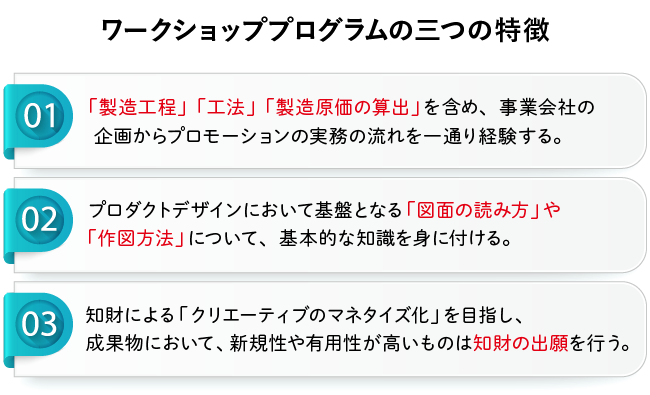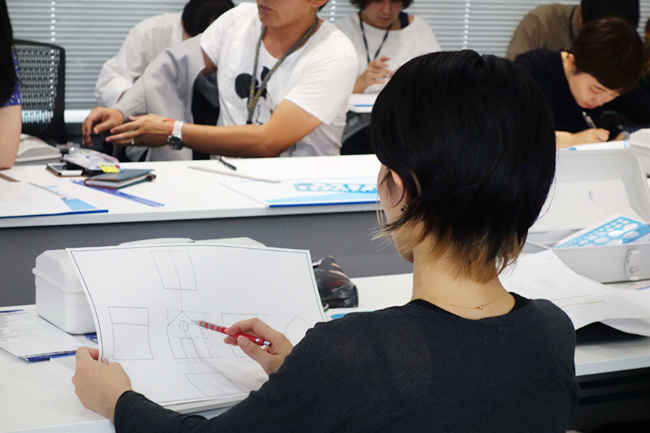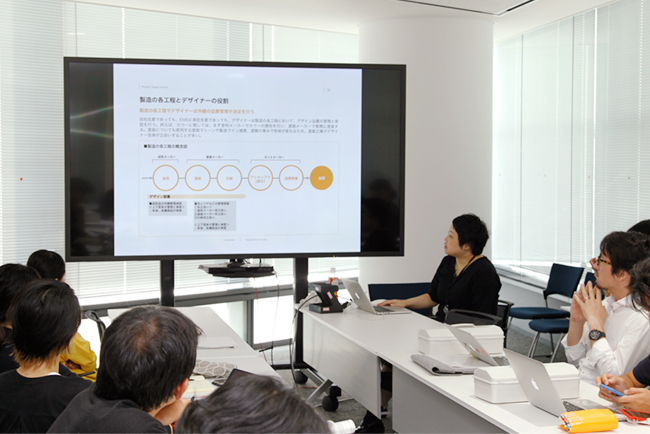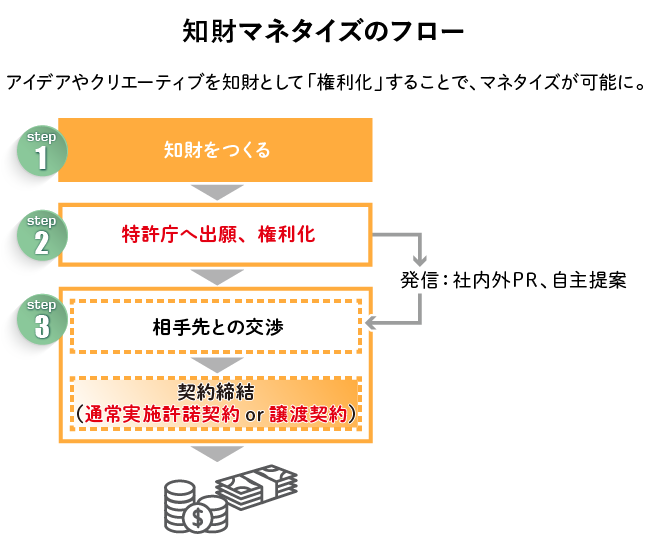At Dentsu Inc., we have launched an initiative called "Intellectual Property Monetization" to leverage the creative and conceptual strengths cultivated through advertising. While "advertising agencies" and "intellectual property" might seem somewhat distant concepts within the traditional industry culture, actually pursuing this initiative has yielded significant promise for the potential of "Dentsu Inc. × IP."
Mitsuko Hotta, who holds dual roles at CDC (responsible for Dentsu Inc.'s creativity and cutting-edge technology) and the Legal Department's Intellectual Property Division, bringing perspectives from both creativity and IP, will explain Dentsu Inc.'s approach and objectives for intellectual property monetization.
The Beginning: "Product Design School 2017"
In 2017, I organized a workshop program called "Product Design School 2017" for Dentsu Inc. in-house creators.
After announcing it to the company's creative departments, 29 participants were selected from applicants, including art directors, planners, and copywriters. For most, it was their first time tackling product design.
The creations resulting from this program were displayed in the first-floor entrance of the headquarters, so some readers may have seen them. Let's take a look at a few.
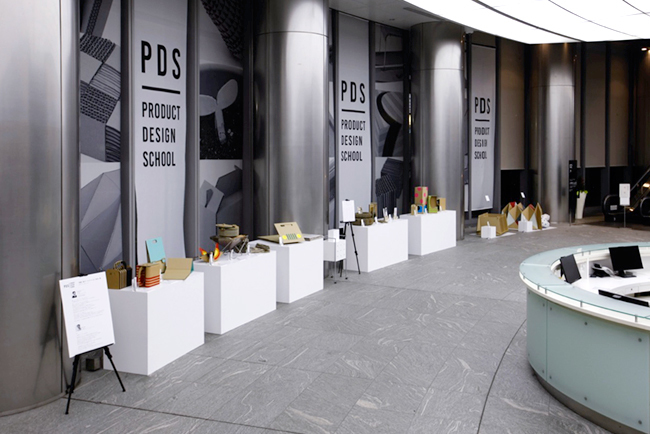
Product ideas by 29 Dentsu Inc. creators displayed in the 1st-floor entrance of Dentsu Inc. headquarters
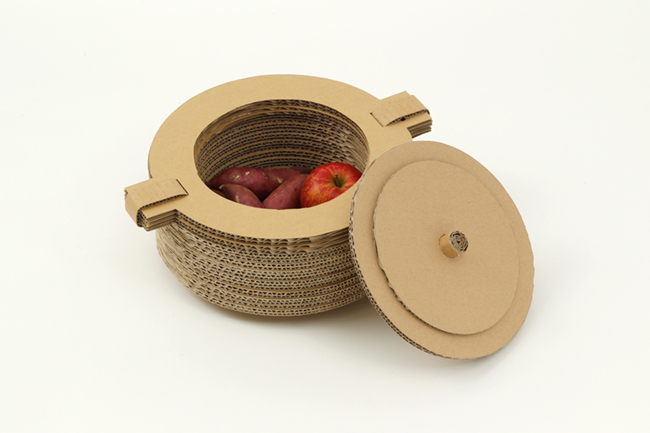
"Paper Pot" that burns away / 5CRP Bureau, Kengo Aoki—An outdoor cooking gadget where ingredients like sweet potatoes are placed inside, and the entire pot is burned to cook.

Used Glasses Lens Container "D-GLASSES" / 1CRP Bureau, Yui Takashima—Designed to allow unused glasses lenses to be used as makeshift glasses during disasters, etc.
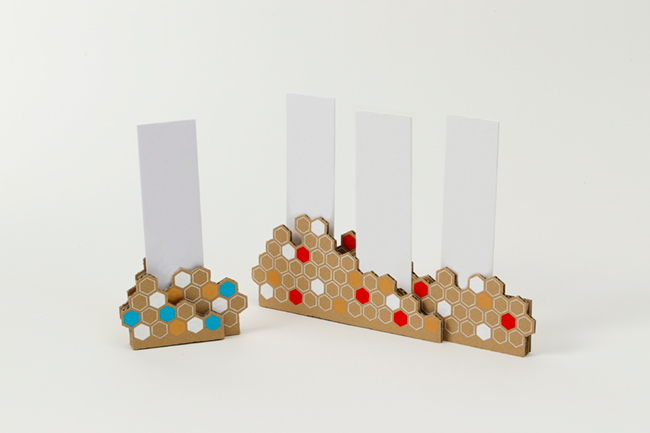
Ofudana: A stylish shrine for talismans in modern homes without a kamidana / 2CRP Bureau・Yuko Katsumata―A stylish talisman holder that allows you to return the talisman to a shrine or temple after one year to be burned together with it.
To briefly introduce myself, before joining Dentsu Inc., I worked as a product designer at a manufacturing company. That experience led me to think, "Couldn't advertising creators expand their skills into the product domain to create products with unprecedented approaches?"
Recently, even at Dentsu Inc., initiatives "outside the advertising domain" are increasing. Amidst this, seeing significant potential in product-related business as an area where an advertising agency's strengths can be leveraged, I planned this school.
This workshop program provides hands-on experience with the entire practical workflow of a business company, from planning to promotion. It requires knowledge of "overall manufacturing" beyond just design, and a key feature is that creators themselves calculate elements like "manufacturing costs."
Furthermore, by incorporating the process of acquiring intellectual property rights for each participant's creations, we also aimed to include the subsequent monetization of intellectual property. For product designers at manufacturing companies, applying for intellectual property rights is a routine part of their daily work process when designing products.
This time, participants repeatedly cycled through "designing," "drawing blueprints," and "crafting with their own hands." They consistently worked to align the designs in their minds, the blueprints, and the final outputs. Feedback included comments like, "Drawing the blueprints was tough, but it was great to have a tangible, hands-on experience," and the program was highly praised as an experience that expanded their skills.
This workshop focused on the theme of "tools made from cardboard." Cardboard was chosen because it is an accessible material, easy to process, low-cost, and easy to handle. Furthermore, considering actual business deployment, it eliminates the need for molds, allowing manufacturing companies to develop products quickly with minimal initial investment, making it easier to try.
One objective of this workshop program was "intellectual property filing." Based on the participants' unique and novel ideas and designs, we ultimately filed two patent applications and twelve design applications.
Regarding designs specifically, considering that Dentsu Inc. previously filed only a few per year, this initiative has become a driving force for "creating intellectual property."
We will continue to run "Product Design School 2018" this fiscal year. We look forward to your continued interest in these activities.
Are there really companies that want to use Dentsu Inc.'s intellectual property?
The basic mechanism for monetizing intellectual property involves a "licensor" granting a license and receiving royalties (compensation for the use of intellectual property rights) from the "licensee" who adopts it. Generally, royalties for designs are said to be 3-5% of manufacturing costs.
The steps for intellectual property monetization are broadly divided into three stages.
Step 1: "Create Intellectual Property"
First, create some form of intellectual property. At Dentsu Inc., we have established a policy to actively pursue intellectual property rights in areas effective for our core businesses, such as "ad tech" and "data & digital." For other areas, we carefully select and scrutinize only those that connect to product domains or business opportunities for intellectual property development.
Step 2: "File with the Patent Office and Secure Rights"
Rather than patenting everything indiscriminately, we collaborate with external patent attorneys to conduct prior art searches. We also evaluate intellectual property from perspectives such as "novelty," "uniqueness," "business potential," "business contribution," and "social contribution," enabling effective and strategic patent applications.
Step 3: "Negotiate with Counterparties → Conclude Agreements"
For "intellectual property rights" that we have applied for and secured rights to, we negotiate with counterparties to establish "license agreements." The contract forms include a "Standard License Agreement," which assumes a royalty-based contract as mentioned earlier, and an "Assignment Agreement," which involves the outright purchase of the rights.
We sometimes receive internal questions like, "Are there really parties who want to use Dentsu Inc.'s intellectual property?" The answer is YES.
Business activities like licensing agreements and transfers with other companies have long existed in industry. Furthermore, with the advancement of open innovation, activities such as externally providing one's own intellectual property and, conversely, introducing intellectual property from other companies are becoming increasingly important and active.
● Benefits for the Acquiring Company
For the acquiring company, benefits include reduced technology and design development costs, shortened schedules, and reduced third-party infringement risks.
Specifically, for companies that "possess technical and production capabilities but lack ideas or design strength, or do not even have an in-house design department," licensing design rights from other companies can minimize initial investment costs.
This also applies when companies primarily engaged in B2B business shift toward B2C by planning and designing products for consumers.
●Benefits for the Licensing Company
They can generate new revenue streams such as licensing income and transfer income.
Our first IP monetization product launches soon!
For Dentsu Inc., actively securing rights and utilizing its own intellectual property has been relatively uncommon until now. However, I believe the strength of Dentsu Inc.'s "creativity" and "ideas" is a treasure trove of intellectual property potential.
The Dentsu Inc. creators who participated in "Product Design School 2017" were not experts in product design. Yet, the unexpectedly strong results achieved in such a short time made me feel there is significant potential for Dentsu Inc. creators to excel in the "product domain."
This series of initiatives leveraging intellectual property, such as design rights, represents a new business for Dentsu Inc. and may be a small step toward "business transformation." Excellent ideas and unique creative work can only be sustainably utilized and monetized once they are secured as intellectual property rights.
Furthermore, displaying workshop creations in the entrance area on the first floor of Dentsu Inc.'s headquarters led to an approach from a cardboard manufacturer, resulting in the decision to commercialize a specific product. For Dentsu Inc., this marks the "first product commercialization through design patent licensing."
Following the scheme of "creating IP," "securing rights," and "turning it into business," this is an example of IP monetization achieved in a short timeframe of about seven months, from exhibition to launch.
Next time, using this " first IP monetization product " as an example, we will introduce the specific development story leading up to its commercialization.





